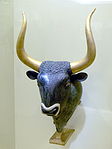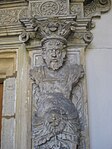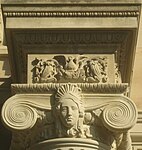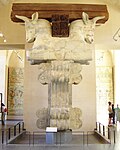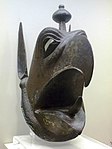Protome

A protome is a three-dimensional work of art that represents the front part of an animal or human and is usually connected to another object.
description
Protomes are sculptural works of art that the front or top of an animal, a mythical creature, or a person in frontal view represented. The front or upper part is understood to mean a mask , a head with or without a neck, a bust or a half-figure .
Protomes were mostly connected as dependent works of art (appliques) with vessels, devices, jewelry, sculptures or buildings. Independent works of art were the head protomes of female deities used by the Greeks as consecration gifts.
Many objects, which by definition are protomes, are usually referred to with their own terms. This applies e.g. B. for appropriately designed busts , herms , masks and mascarons , angel heads, portrait medallions , attaches , gargoyles and acroters .
history
Number in brackets: number of a picture example.
A comprehensive and systematic investigation of the historical development of the protomes is lacking.
The oldest examples of protomes (four rams) can be found in a lamp or a sacrificial bowl from Szeged from the Neolithic Tisza culture in Hungary . Later then on the animal head rhyta , z. B. on Minoan bull head rhyta from the 16th century BC. Chr. ( 2 ) and on Hittite from the 15th – 13th centuries Century BC ( 12 ).
Protomes were also used to decorate cauldrons with tripod bases. The earliest specimens date from the 8th century BC, e.g. B. cauldrons with bull protomes from Urartu , which influenced the archaic cauldrons from Olympia ( 14 ) and Samos , decorated with griffins and other animal protomes (from the 7th century BC). In Etruscan tombs of the 7th century BC, cauldrons with snake protomes ( Tomba Bernardini in Palestrina ) and panther protomes ( Tomba Regolini-Galassi in Cerveteri ) were found.
Bull, lion and griffin protomes on jewelry ( 9 ), devices ( 6 ), vessels ( 15 ) and monumental saddle capitals ( 10 ) are known from Susa and Persepolis from the Achaemenid period .
So far there is no comprehensive description of the use of the protomes after antiquity. The gallery shows some examples from modern times ( 3, 7, 8, 11, 13 ).
Word origin
The word protome is derived from ancient Greek προτομή (protomé) "the front or upper part of an animal", which is based on the verb προτέμνω (protémno) "cut off".
Translations
| language | Singular | Plural | Emphasis |
| German | the protomes | the protomes | protoˡme, proˡtomen |
| English | the protome | the protomes | ˡprotome, ˡprotomes |
| French | le protomé | les protomés | |
| Italian | la protome | le protomi | ˡprotome, ˡprotomi |
| Spanish | el prótomo | los prótomos |
gallery
Image 4: Two protomes with male busts on the gallery of the castle church in the old castle in Stuttgart, 16th century.
Image 5: Fighter relief with ram protome at Villa Berg in Stuttgart, around 1851.
Image 6: Corinthian Olpe with double horse protome, 575–550 BC.
Image 7: Achaemenid sword pommel with double bull protome from Susa , 6. – 5. Century BC.
Image 8: Herme with (a) grimace protomes on the belly and (b) two lion protomes on the arm stumps in the old castle in Stuttgart, 16th century.
Image 9: Ionic capital with a female head protome at the Villa Berg in Stuttgart, around 1850.
Image 10: Achaemenid bangle with griffin double protomes from the Oxus treasure , 5th – 4th centuries. Century BC.
Image 11: Saddle capital with double bull protome from Susa , around 510 BC.
Image 12: Console with mask protome at the Prinzenbau in Stuttgart, 1715.
Image 14: Fountain on Schloßplatz in Stuttgart with lion mask protomes, 1863.
Image 15: Head part of a griffin protome from Olympia , 7th century BC.
Image 16: Detail from an Achaemenid relief in Persepolis with an amphora with griffin protomes, 6. – 5. Century BC.
literature
Dictionaries
- Salvatore Battaglia : Grande dizionario della lingua italiana , Volume 14, Turin 1988, p. 756.
- Louis Guilbert (editor); René Lagane (collaboration): Grand Larousse de la langue française: en 6 volumes , Volume 5, Paris 1976, p. 4718.
- Paul Imbs (ed.): Trésor de la langue française: dictionnaire de la langue du XIXe et du XXe siècle (1789-1960) , Volume 13, Paris 1988.
- Ursula Kraif (editor): Duden, the great foreign dictionary: origin and meaning of foreign words , Mannheim 2007, p. 1113.
- Henry George Liddell ; Robert Scott : A Greek-English Lexicon, revised and augmented throughout by Sir Henry Stuart Jones , with the assistance of Roderick McKenzie , Oxford 1940, keyword προτομή [1] , keyword προτέμνω [2] .
- Wilhelm Pape : Greek-German Concise Dictionary , Volume 2, Braunschweig 1880, keyword προτομή, p. 793 [3] , keyword προτέμνω, p. 791 [4] .
- Manuel Seco ; Olimpia Andrés; Gabino Ramos: Diccionario del español actual , Volume 2, Madrid 1999, p. 3718.
- John A. Simpson : The Oxford English Dictionary , Volume 12, Oxford 1989, p. 697.
Lexicons
- Silvio Feri: Protome. In: Ranuccio Bianchi Bandinelli (ed.): Enciclopedia dell'Arte Antica, Classica e Orientale , Volume 6, Rome 1965, pp. 517-518 ( full text ).
- Brockhaus Encyclopedia in 30 Volumes , Volume 22, Mannheim 2006, pp. 196–197.
- Der Kunst-Brockhaus , Volume 2, Wiesbaden 1983.
- PW Hartmann: Das Großes Kunstlexikon , without location 1996, keyword Protome [5] .
- Harald Olbrich (Ed.): Lexikon der Kunst , Volume 5, Leipzig 2004, p. 771.
- Wolf Stadler (ed.); Ferdinand Anton (collaboration): Lexicon of Art: Painting, Architecture, Sculpture , Volume 9, Freiburg 1989, p. 298.
Monographs
- Marcella Barra Bagnasco: Protomi in terracotta da Locri Epizefiri. Contributo allo studio della scultura arcaica in Magna Grecia , Il Quadrante, Turin 1986.
- Silvio Ferri: Archeologia della protome . In: Annali della Scuola Normale Superiore di Pisa, Classe di Lettere e Filosofia Ser. 2, 2, 1933, pp. 147-158.
- Werner Gauer : The bronze vessels of Olympia: with the exception of the geometric tripods and the cauldrons of the oriental style: cauldrons and basins with saucers, plates, craters, hydria, buckets, situles and cisterns, scoop pumps and various devices , de Gruyter, Berlin 1991, p 13-17.
- Ulrich Gehrig : The griffin protomes from the Heraion of Samos (= Samos , vol. 9). Habelt, Bonn 2004, ISBN 3-7749-3271-9 .
- Hans-Volkmar Herrmann : The cauldrons of the orientalizing time. 2. Kettle protomes and tripods , de Gruyter, Berlin 1979.
- Alfred Mallwitz : Olympia and his buildings , Prestel, Munich 1972, pp. 46–51.
- Klaus Tuchelt : Animal vessels in head and protome shape. Investigations into the history of the shape of animal-headed watering vessels , Gebr. Mann, Berlin 1962.
Web links
Individual evidence
- ↑ For emphasis see: Translations .
- ↑ The definition in the article Applike is too narrow, since it only considers flat appliqués.
- ↑ Barra Bagnasco 1986 ; Brockhaus 2006 .
- ↑ Head with winged breast.
- ↑ There are several monographs on the history of the vascular protomes .
- ↑ Marija Gimbutas: The civilization of the goddess two thousand and one Frankfurt a / M 1996 plate 13
- ↑ Mallwitz 1972 .
- ↑ Brockhaus 2006 categorized - deviating from his own definition - the full-body lion figures of the bronze cauldron of Hochdorf as "lion protomes".
- ↑ Brockhaus 2006 offers only a few examples.
- ↑ Liddell-Scott 1940 ; Pape 1880 .
- ↑ Kraif 2007 .
- ^ Simpson 1989 .
- ↑ Guilbert 1976 .
- ^ Battaglia 1988 .
- ^ Seco 1999 .


